There are no more articles in this theme in your language.
How much should the kid eat?
2011.05.22.
Besides the „What should the kid eat?” question this is the next major problem, more precisely: how much and how many times should the kid eat?
The question of quantity is rather easy to answer, as it is written on all food cans how much an average 5 kg cat should eat one day; and the same way if the cat is thin or somewhat overweight (although we know, it is only her fur).
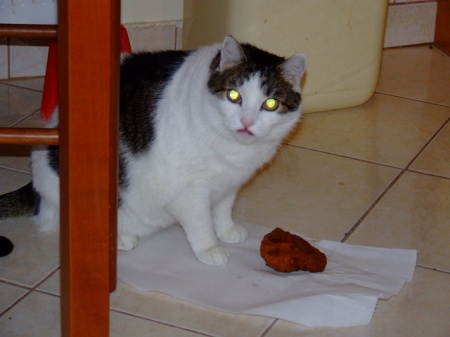
The dosage contains the eating order of pregnant and nursing cats and in the case of junior food the eating order of kittens as well. The cats are junior until about the age of 1. Until the 5-6th week the feeding is the mom’s task, as kittens can be fed solely with breast milk this time – or with formula in the absence of the mother cat. Solid food can be given from the 7th week, but only in the form of special junior feed. The little ones can crunch dry cat food from the 8th week.
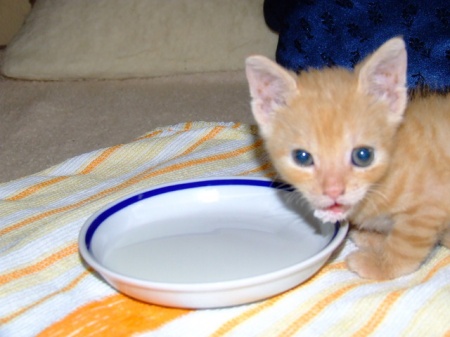
But let’s move on to the adult cats!
If we give both dry and wet food and this option is not written, logically both amounts have to be halved. (The packages of many food indicate both the bag and the bowl together, this means that we give both of them to the cat.) Here we can bust the theory that premium pet food is pricelessly expensive, because even though it is more expensive if we look at the amount, but much less is needed per portion than from the food advertised on television. For example if we take that a normal cat needs 2-3 packets a day from W brand, but only one from the RC brand we can wee that it is practically the same price. As for the dry food we have to give significantly less from the premium qualities than the cheaper ones because the very important nutrients are in this, moreover they are available according to age and other features in different compositions, so it is not advised to save money on dry food either. The danger is that it is rather easy to overfeed the cat with these products, so at first we have to take out the scale and measure the portions exactly or use the measuring cup that is usually given with the food for free!
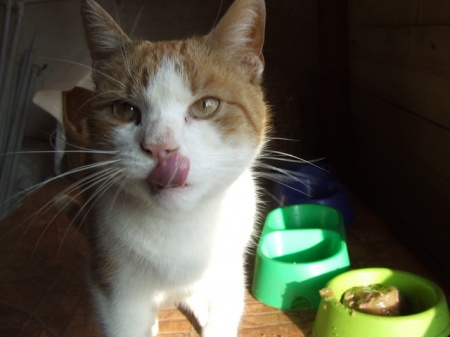
The other important question is, how many times a day should the cat eat? The general standpoint regarding adult cats is similar to dogs, so once or twice at the maximum. However I – thinking through the circumstances – do not agree with this all and indeed not one vet justified my theory when I asked around. The thing is the cat’s stomach is rather small compared to its body and it is not made for the process of „rarely much” food. The cat is always hunting in the nature or if it is free and many times catches a rodent, a bird or some plants if there is nothing else to chew. If we are starting from here how would it be enough for the cat to stuff its little stomach once a day to the fullest? Even though cats are able to spend many-many hours asleep, this still seems very little. Therefore I took a risk and tried this: my neutralised cat that is kept in a flat gets wet food twice a day (one premium package divided into two), and the half-a-day portion dry food is always out. The method works perfectly: the cat is of normal size, never gains weight and is able to economise the portions to herself.
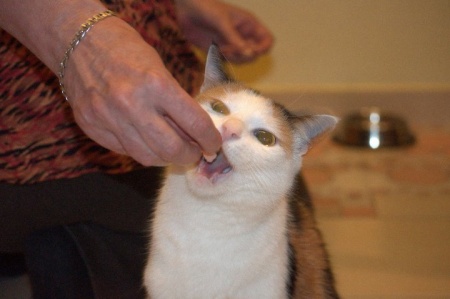
If I spend more time at home and she is awake for more hours, runs around more than she eats more wet food and vica versa; and she does not wake me up in the middle of the night either because she is starving because she knows where to find the dry food. Of course not all cats are like this, there are some that continue to eat until there is food – like dogs – especially if there are more cats and they fear for their own portion. If we see that one of our cats is gaining weight while the other loses, we again have to determine the portions and supervise how much they eat. However the former method is worth a shot anyway, as this is closer to the basic nature of the cat.
We can give treats between daily regular meals, one at a time (per day) or one slice of cold meat, do not spoil the cat!. If we offer her fresh meat (strictly fresh, well cleaned poultry or beef, occasionally fish) let’s not get carried away, 1-2 occasions a week is totally enough or when the preparations of our own dinner makes it possible! We should give the cat the amount of chopped fresh meat at once that does not exceed 1 tablespoon. We can give her egg yolk to improve the condition of her fur, this is perfectly enough once in two weeks – even if the cat polishes it off in one second.
Ági és Zsuzsi
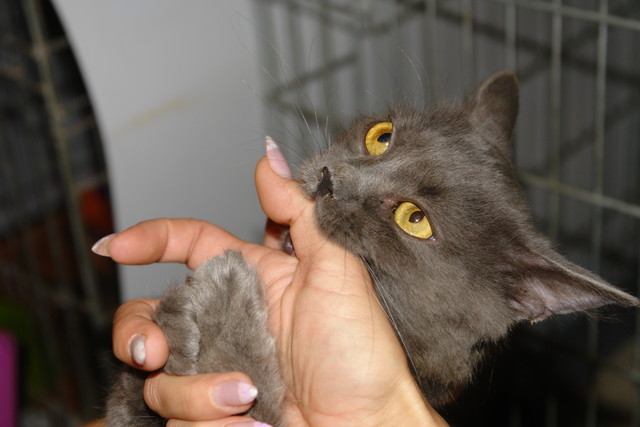
The question of quantity is rather easy to answer, as it is written on all food cans how much an average 5 kg cat should eat one day; and the same way if the cat is thin or somewhat overweight (although we know, it is only her fur).

The dosage contains the eating order of pregnant and nursing cats and in the case of junior food the eating order of kittens as well. The cats are junior until about the age of 1. Until the 5-6th week the feeding is the mom’s task, as kittens can be fed solely with breast milk this time – or with formula in the absence of the mother cat. Solid food can be given from the 7th week, but only in the form of special junior feed. The little ones can crunch dry cat food from the 8th week.

But let’s move on to the adult cats!
If we give both dry and wet food and this option is not written, logically both amounts have to be halved. (The packages of many food indicate both the bag and the bowl together, this means that we give both of them to the cat.) Here we can bust the theory that premium pet food is pricelessly expensive, because even though it is more expensive if we look at the amount, but much less is needed per portion than from the food advertised on television. For example if we take that a normal cat needs 2-3 packets a day from W brand, but only one from the RC brand we can wee that it is practically the same price. As for the dry food we have to give significantly less from the premium qualities than the cheaper ones because the very important nutrients are in this, moreover they are available according to age and other features in different compositions, so it is not advised to save money on dry food either. The danger is that it is rather easy to overfeed the cat with these products, so at first we have to take out the scale and measure the portions exactly or use the measuring cup that is usually given with the food for free!

The other important question is, how many times a day should the cat eat? The general standpoint regarding adult cats is similar to dogs, so once or twice at the maximum. However I – thinking through the circumstances – do not agree with this all and indeed not one vet justified my theory when I asked around. The thing is the cat’s stomach is rather small compared to its body and it is not made for the process of „rarely much” food. The cat is always hunting in the nature or if it is free and many times catches a rodent, a bird or some plants if there is nothing else to chew. If we are starting from here how would it be enough for the cat to stuff its little stomach once a day to the fullest? Even though cats are able to spend many-many hours asleep, this still seems very little. Therefore I took a risk and tried this: my neutralised cat that is kept in a flat gets wet food twice a day (one premium package divided into two), and the half-a-day portion dry food is always out. The method works perfectly: the cat is of normal size, never gains weight and is able to economise the portions to herself.

If I spend more time at home and she is awake for more hours, runs around more than she eats more wet food and vica versa; and she does not wake me up in the middle of the night either because she is starving because she knows where to find the dry food. Of course not all cats are like this, there are some that continue to eat until there is food – like dogs – especially if there are more cats and they fear for their own portion. If we see that one of our cats is gaining weight while the other loses, we again have to determine the portions and supervise how much they eat. However the former method is worth a shot anyway, as this is closer to the basic nature of the cat.
We can give treats between daily regular meals, one at a time (per day) or one slice of cold meat, do not spoil the cat!. If we offer her fresh meat (strictly fresh, well cleaned poultry or beef, occasionally fish) let’s not get carried away, 1-2 occasions a week is totally enough or when the preparations of our own dinner makes it possible! We should give the cat the amount of chopped fresh meat at once that does not exceed 1 tablespoon. We can give her egg yolk to improve the condition of her fur, this is perfectly enough once in two weeks – even if the cat polishes it off in one second.
Ági és Zsuzsi

A Tetszik gomb eléréséhez sütik engedélyezése szükséges.
 Megosztom a Facebookon
Megosztom a Facebookon

 Magyar
Magyar Deutsch
Deutsch









